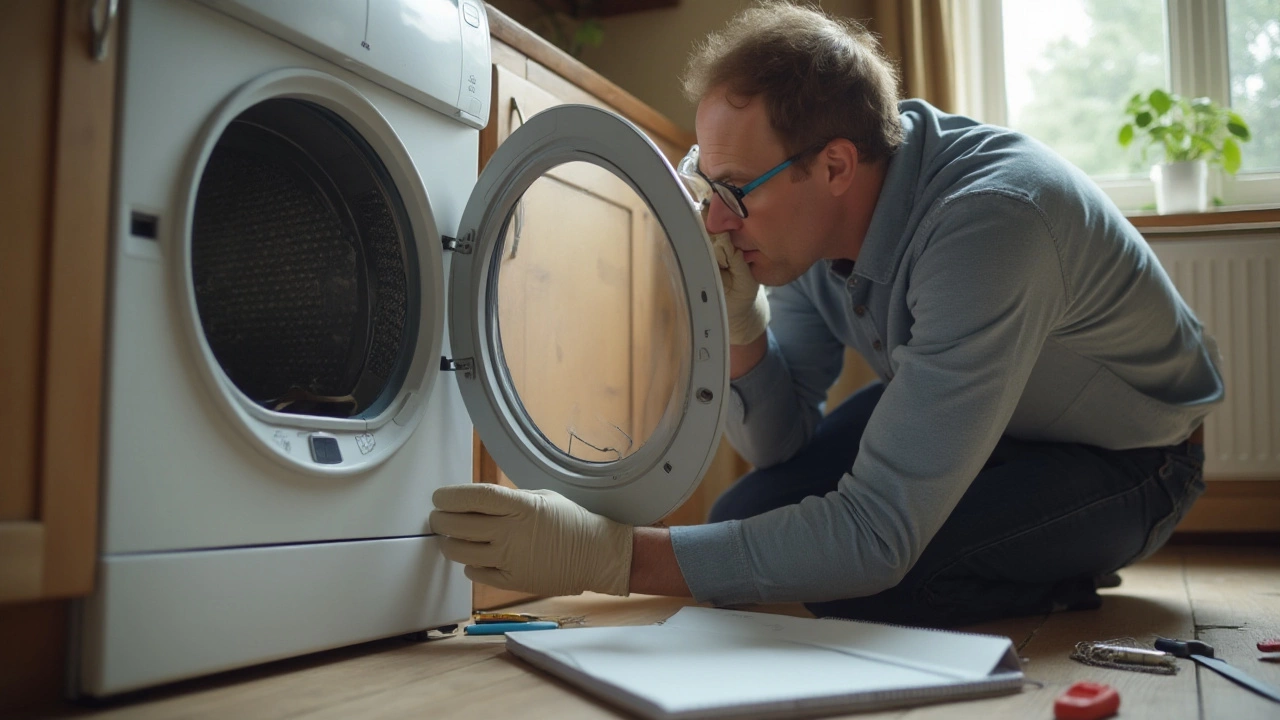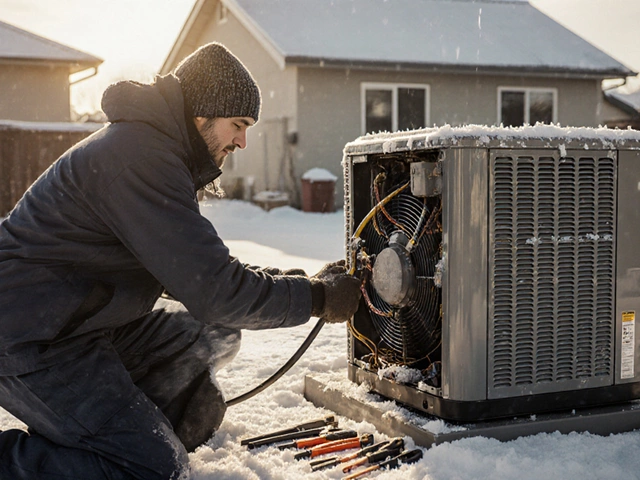Picture this: It’s a Sunday morning, laundry piled high, and your trusty dryer throws in the towel just when you need it most. A dryer’s refusal to perform its duties is a call for action, but the big question looms—should you repair it or move on to the next best thing? Knowing how to approach this dilemma could save you both time and money.
In the labyrinth of modern appliances, a dryer is a staple, whisking away hours of hanger time and weather dependency. Yet, like any hardworking contraption, it’s not immune to hiccups. From mysterious thuds to silent spins, many a dryer has faltered, leaving weary owners to ponder its fate. Fear not; we are here to inspect when a repair is worth its salt or if it’s time to bid farewell and eye a sleeker model.
Join us as we delve into common dryer malfunctions, weigh the financial scales, and offer pointers that may just turn you into the hero of home appliance upkeep.
- Understanding Common Dryer Problems
- Cost Analysis: Repair vs Replace
- When DIY Repairs Make Sense
- Choosing a Professional Repair Service
- Extending Your Dryer's Lifespan
- Innovative Alternatives to Consider
Understanding Common Dryer Problems
Dryers are relatively simple devices but can present a range of issues when they start to falter. Identifying these problems early can save significant hassle and expense. Understanding what might be ailing your appliance is the first step in determining whether a dryer repair is in order.
1. The Dryer Won't Start
This is possibly the most dreaded scenario for any dryer owner. A non-starting appliance might result from a tripped circuit breaker, a faulty door switch, or even a damaged thermal fuse. It's always worth checking that the dryer is properly plugged in and that the circuit is intact.
2. Inadequate Drying
Nothing's worse than opening the dryer door only to find damp clothes. This could be caused by a clogged lint filter, an overblown heating element, or a blocked vent restricting the airflow. Cleaning out the vents and the lint filter should be your first port of call.
3. Unusual Noises
A dryer making odd knocks or vibrations might seem like it's communicating in Morse code, but this is typically an issue with the drum or the motor. Loose objects caught in the drum or a worn-out drum roller can easily lead to such disturbances. Inspecting the dryer drum and ensuring nothing is out of place can help mitigate these issues.
Some Statistics on Dryer Problems:
| Problem Type | Percentage of Occurrence |
|---|---|
| The dryer won't start | 25% |
| Inadequate drying | 40% |
| Unusual noises | 15% |
| Other issues | 20% |
4. Overheating and Burning Smell
If you ever detect a burning aroma coming from your dryer, it’s important to shut it off immediately. A dryer producing excessive heat often signals clogged vents or a failing thermostat. Both conditions require prompt attention to avert more severe damage or potential fire hazards.
5. Error Codes
Modern dryers are equipped with digital panels that display error codes. These codes can guide you in diagnosing the issue. Refer to your dryer's manual to decipher these cryptic messages and gain insight into what’s going wrong.
By identifying and understanding these common dryer issues, you are better equipped to decide whether a quick appliance repair is worth pursuing or if it’s time to upgrade to a new model. Swift action on these common errors can save a significant amount of money and extend the life of your dryer substantially.
Cost Analysis: Repair vs Replace
When your beloved dryer starts acting up, you might find yourself standing in front of it, almost pleading for it to work. But emotional connections aside, it’s crucial to weigh the costs of repairing your current appliance against purchasing a brand new one. This decision isn’t just financially significant but also environmentally impactful.
Assessing the Scope of the Problem
Start by diagnosing the issue. Is it a minor fix, like a faulty thermostat, or has the motor given out completely? A new thermostat may only set you back around $50 and can often be a do-it-yourself job. In contrast, replacing a motor could cost upwards of $200, and might require a professional, which adds to the expense.
Let’s consider the age of the dryer. Most appliances have a lifespan, and given adequate care, a dryer can keep working efficiently for about 10-13 years. If your dryer is approaching this age range, replacement might be inevitable in the near future.
Financial Breakdown
Here's a simple comparison to help you decide:
| Component/Service | Average Repair Cost |
|---|---|
| Thermostat | $50 - $100 |
| Belt | $150 - $200 |
| Heating Element | $170 - $280 |
| Professional Service | $100 - $200 per visit |
| New Dryer | $400 - $1,500 |
If the repairs cost more than half the price of a new tumble dryer, or if the dryer is older than midpoint of its lifespan, replacing might be the wiser option.
Environmental Considerations
Before writing off your old dryer, consider the environmental toll of disposal and manufacturing a new unit. Repairing extends your dryer’s lifespan and reduces waste. Small actions towards sustainability can contribute significantly to lessening household carbon footprints.
Conclusion
In the battle of repair versus replacement, the decision often lies in the specifics: the nature of the damage, the age of the machine, and long-term cost benefits. Ultimately, making an informed choice requires balancing financial considerations with practical and environmental impacts.
When DIY Repairs Make Sense
If your dryer has suddenly decided to stop cooperating, there’s no need to panic. Sometimes the quickest solution isn't found in the back of a service truck but within your own toolkit. Understanding when you can tackle a problem yourself can save a ton of cash without compromising on quality.
Common DIY Fixes
Many of the issues you'll encounter with a tumble dryer are surprisingly straightforward to fix. Here are some common problems and DIY solutions:
- Drum Not Turning: This can happen if the drive belt has snapped. Simply replace the belt—a part you can often find for less than $20.
- No Heat: Check the thermal fuse or heating element. These components can be acquired easily and replaced with a standard screwdriver and some patience.
- Strange Noises: Likely caused by worn drum rollers or a failing bearing, which are inexpensive parts to replace.
Tools You’ll Need
Before getting started, ensure you have the following tools at hand:
- Screwdriver set
- Multimeter
- Needle-nose pliers
- Adjustable wrench
"Ninety percent of the issues with dryers are common faults that do not require professional intervention," notes Mike Miller, a seasoned appliance technician with over 20 years of experience.
Safety First
Whenever you’re dealing with electrical appliances, safety is crucial. Always ensure the dryer is unplugged before you start any repair. If you’re dealing with gas dryers, turn off the gas supply. Wearing gloves can also provide an extra layer of protection.
Knowing Your Limits
Despite the allure of DIY, there are instances when professional help is necessary. Complex issues involving the dryer's electrical system or gas line should be reserved for licensed professionals. As they say, it’s better safe than sorry, especially when dealing with potential fire hazards.
At the end of the day, knowing when DIY repairs make sense can distinguish you from just another appliance owner. If you’re confident in your skills and equipped with the right tools, rolling up your sleeves and tackling the problem head-on could keep your dryer spinning smoothly and save a significant amount of greenbacks.

Choosing a Professional Repair Service
Determining when to call in a professional for dryer repair can be a tough call. There's nothing like expertise, however, to ensure your tumble dryer gets the precise care it needs, preventing further issues down the road. Let's unravel the key considerations in selecting a repair service that won't leave you high and dry.
Researching Your Options
Start by gathering a list of local appliance repair services that specialize in tumble dryers. A quick online search paired with reviews can reveal plenty about a company's reputation and reliability. Websites like Yelp and Angie's List are excellent resources for customer feedback. Not to mention, word-of-mouth recommendations from friends or neighbors can also be invaluable.
Certification and Experience
Once you've narrowed down a few contenders, verify their credentials. Look for technicians who are certified by recognized trade organizations such as the Professional Service Association (PSA) or the United Appliance Servicers Association (UASA). Certification often means the technicians have undergone rigorous training and are up-to-date with the latest repair techniques.
Experience, as they say, is the best teacher. A company that's been in the business for a while is likely familiar with myriad issues your dryer might face and can offer solutions that stand the test of time.
Service Guarantees and Pricing
Understand what guarantees or warranties a repair service offers. A solid warranty can provide peace of mind, ensuring that if the same issue recurs, you'll be covered at no additional cost. When discussing cost, clarity is crucial. Ask for an estimate before work begins, and ensure it aligns with industry standards in your area.
| Issue | Average Cost |
|---|---|
| Thermal Fuse Replacement | $100 - $150 |
| Belt Replacement | $150 - $200 |
| Motor Repair | $200 - $300 |
Availability and Response Time
Consider how quickly a company can respond to your call. Some repair services offer same-day or next-day service, which can be a lifesaver, especially during laundry emergencies. Additionally, check if they offer flexible scheduling or service on weekends when it's most convenient for you.
Customer Service
A repair service's commitment to excellent customer service can make all the difference. From the first phone call to the interaction with the technician in your home, a professional demeanor, clear communication, and transparency can indicate a company's professionalism and dedication to quality.
Choosing the right professional for dryer repair involves a careful balance of research, credentials, cost, and customer care. By considering these factors, you can ensure that your dryer receives the best possible service, keeping your household running smoothly and your clothes perfectly fluffed.
Extending Your Dryer's Lifespan
Every item we use daily gains a special place in our routine, not just because it's practical, but because we've learned to rely on it. Your dryer, performing its silent duty, is no different. Yet, just like an old friend, it needs periodic attention and care to keep it running smoothly. Let’s explore how a bit of TLC can extend the lifespan of your trusted tumble dryer.
Regular Cleaning and Maintenance
The number one killer of dryers is lint build-up, which can not only cause inefficient drying but pose a serious fire hazard. To counteract this, frequently cleaning the lint trap is paramount. After every load, make it a habit to remove the lint that accumulates.
Every few months, take steps to clean the dryer vent system. A vacuum hose attachment can help to remove stubborn lint that clings to the walls of vents. Also, examine the venting hose and the exterior exhaust vent to ensure no clogs or damage, which would impede efficiency.
Balancing and Leveling
Imagine an unbalanced load of laundry thumping around inside a dryer. Not only does this wear out the internal components faster, but it can also reduce the dryer’s efficiency. Ensure your dryer is on a level surface and that all four feet are properly adjusted.
Load Size and Composition
Overloading your dryer might seem like it saves time, but in reality, it puts a burden on both the motor and drum belt. Load your dryer enough to allow clothes to tumble freely. Sometimes, less is more, and your dryer will thank you with extended life.
Balanced Load Sizes
- Optimize medium loads for best results.
- Avoid drying heavy items together.
- Utilize dryer balls to prevent bondage of wet clothes.
The Right Settings for Every Fabric
Get acquainted with your dryer’s settings. Different fabrics require different heat settings, and using a higher temperature than necessary can not only damage clothing but shorten your dryer's lifespan. Consult fabric care labels and adjust accordingly.
Ocassional Professional Check-Ups
Like any well-worn machine, professional maintenance can spot issues before they escalate. An annual inspection might reveal worn belts or faulty sensors that you can address proactively.
Consider the following maintenance checklist:
- Inspect for unusual noises or vibrations.
- Check the drum seal for wear and tear.
- Verify thermostat and moisture sensors for accurate readings.
Following these preventative measures can significantly extend your dryer’s lifespan. Remember, maintaining your appliance isn't just about keeping one less item on the shopping list, it’s about efficiency, safety, and, sometimes, a little peace of mind.
Innovative Alternatives to Consider
When weighing the decision to repair or replace your dryer, don’t overlook the charm of innovative alternatives hitting the market. Household appliance technology is evolving, making room for eco-friendly and smart solutions that promise efficiency and savings. Let's explore some of these groundbreaking options that may redefine how you tackle laundry chores.
Eco-friendly Dryers
In the quest for sustainability, consider venturing beyond the traditional tumble dryer. Heat pump dryers have emerged as a game-changer, using a closed-loop heat exchange system to significantly reduce energy consumption by up to 50%. Although they might be more expensive upfront, the reduction in energy bills can pay off in the long run.
A study by the International Energy Agency found that energy-efficient appliances can lead to substantial savings—making heat pump dryers not only environmentally sound but economically wise investments.
Smart Dryers
Smart technology is gradually infiltrating all areas of home life, and dryers are no exception. With the introduction of Wi-Fi-enabled dryers, users can now control drying cycles from their smartphones, ensuring optimal operation even when they’re busy elsewhere. Certain models even have sensors that detect moisture levels, automatically adjusting the settings to prevent unnecessary energy usage.
"Smart appliances are not just about convenience but are pivotal in pushing energy conservation to the forefront," shares Anna Martinez, a leading home technology analyst.
Hybrid Options
For those still attached to their traditional tumble dryers but wish to add an eco-friendly touch, hybrid solutions might just hit the sweet spot. Consider integrating a drying rack or clothesline in tandem with your dryer usage. This approach can naturally dry heavier items, such as towels and jeans, reducing the load on your dryer and extending its lifespan.
Benefits of Hybrid Approaches:
- Reduced wear and tear on the tumble dryer
- Lower energy bills
- Increased longevity of clothing due to less heat exposure
As technology progresses, drying clothes becomes more aligned with environmental consciousness and energy efficiency. So, before deciding on whether to repair that old dryer or not, weighing these innovative alternatives might just offer a fresh and financially prudent perspective.





